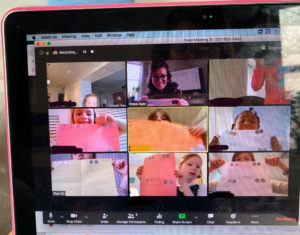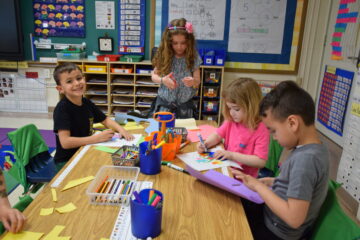
Inside the Cyber Classroom
Elissa Apar, who has been teaching seven years, has a class of eight second- graders in a private girls’ school. We interviewed her about how she and her students are adjusting to what her school calls both Distance Learning and Virtual Learning.
What does your school call this form of teaching?
Mainly Distance Learning, but we also use the term Virtual Learning.
How long did you train?
Two days of training on Zoom, a web-based video conferencing tool, that we are using daily with our students to check in and teach lessons virtually. The teachers have been watching tutorials and exploring the multiple features on Zoom, as well as on Google Classroom, which is new to all of us.
Who trained you?
The technology specialist trained us during professional development for two days, but other than that we trained through video tutorials and learned on our own. The great part about our teacher community is how we help one another. For example, the more ‘tech-savvy’ teachers who started understanding the virtual learning apps quickly began helping and guiding the other teachers who were having more difficulty.
How long did it take you to get used to Virtual Learning?
Growing up in a technology-driven society, it didn’t take me long to learn Zoom and Google Classroom as well as make presentations with the aid of services like google slide design, but teachers of previous generations had more difficulty adapting.
Students miss seeing and interacting with their classmates
What was the initial reaction of students?
My second grade students loved seeing their classmates and teacher through what they think of as “FaceTiming.” They do miss seeing and interacting with their classmates and teachers, but what makes them very happy through this difficult and confusing time is knowing that every morning they will get to see and talk to each other in real time.
What are the advantages (if any) vs. classroom teaching?
There aren’t many for teachers, but I see advantages for students, who will learn to be flexible, understand that there’s more than one way of learning, and become more independent, by taking charge of their own learning.
What are the disadvantages (if any) vs. classroom teaching?
Unfortunately, at the elementary level, there are many, many disadvantages compared to classroom teaching. The family has to be involved and present every step of the way, extremely difficult to assess students, students being in their home setting rather than separating the home and school environment, lack of student social interaction/friendship making, higher distraction level, technology complications, the list goes on…
Readers’ workshop and word study (spelling) are easiest to teach
Which subjects are easiest to teach this way?
It truly differs for each grade, but for second grade, and for me personally, I feel that reader’s workshop and word study (spelling) are easiest to teach.
For readers’ workshop, I can still virtually teach my mini lesson with my whole class listening and watching, and then they go off and practice the strategy taught on their own with their own books.
For word study, I typically teach the spelling pattern and then we brainstorm words with those patterns together as a class; so virtually, it isn’t much different, in the sense that I can still make a list of words for the students to see and they can still raise their hands and share their ideas while writing them down.
The great part about Zoom is that I can “share my screen” with my students so I can type up the words they brainstorm on a Google Doc and they can have it right in front of them, like they would in the classroom with me writing on chart paper.
Which subjects are hardest to teach this way?
I would definitely say math and science are the hardest to teach this way. Both subjects are very hands on, using lots of manipulatives and interactive tools for most lessons.
It’s also much more difficult to assess students through distance learning and have small group instruction to reteach concepts that students need extra help with.
With Zoom, the girls can talk to each other, which creates a classroom-like atmosphere
Can students interact with each other or only with you?
Yes! Students can interact with each other during our class Zoom sessions. The teacher has the option to mute all students except for the one that is talking to ensure every one is listening and not talking over one another.
What I love about Zoom is that the girls can talk to each other, which brings a more “classroom like atmosphere” under the circumstances of not physically being together.
Students can also take pictures of their work and share it on our Google Classroom “stream” so other classmates can see what they are working on, it’s great! At this age level, parents have a large part in assisting their daughters navigate Google Classroom since they are so young, but the parents have been extremely supportive and patient. The teachers truly appreciate their flexibility and support through all this.
What kind of group activities are eliminated?
Partnerships, students meeting with their reading and writing partner one on one to conference, working in small groups to solve math problems and share strategies…that is the biggest disadvantage I would say.
The student collaboration is much harder to do virtually, since we Zoom as a whole class and the students are so young they don’t have the ability to interact on Google Classroom, like middle or high school students can do by working on group projects together through a shared Google Doc or Powerpoint presentation.
Any further thoughts?
Distance or Virtual Learning is new to everyone. What I have learned through all this is how incredible the teaching community is, coming together, sharing ideas and resources with one another not only within their schools, but across states.
There is a Facebook Group made for teachers to share their variety of teaching resources at all different grade levels and it has been a great place for support and positivity. I try to remember that this is temporary and how thankful we are for having the technology to be able to teach our students virtually.






